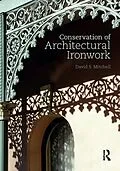Conservation of Architectural Ironwork is the first book to provide a complete up-to-date guide to the conservation and maintenance of traditional architectural ironwork.
Autorentext
David S. Mitchell has worked in ironwork conservation for over 20 years and is currently Director of Conservation for Historic Environment Scotland, the national heritage body in Scotland.
Zusammenfassung
The peak of architectural ironwork in the 19th Century saw the spread of ornate decorative ironwork across the world. In recent years there has been a significant increase in conservation and restoration projects aiming to protect the artistry of traditional ironwork for future generations. Conservation of Architectural Ironwork is the first book to provide a complete guide to the conservation and maintenance of traditional architectural ironwork.First introducing the contextual history and key material features of architectural ironwork, the book goes on to guide readers through the management and delivery of conservation projects from start to finish, explaining the very latest in conservation technology. At its peak, architectural ironwork was used on a vast global scale in buildings, bridges, street furniture and ornamental structures. With international case studies and detailed illustrations, this book will be an essential reference for heritage professionals and students of architectural conservation around the world.
Inhalt
Acknowledgements. Introduction. 1. History 2. Materials 3. Decay Mechanisms and Hazards 4. Survey and Research 5. Managing an Architectural Ironwork Project 6. Intervention 7. Replication of Architectural Ironwork 8. Characteristics and Common Issues Bibliography. Other Sources. Glossary. Index
Titel
Conservation of Architectural Ironwork
Autor
EAN
9781317411765
ISBN
978-1-317-41176-5
Format
PDF
Hersteller
Herausgeber
Veröffentlichung
04.10.2016
Digitaler Kopierschutz
Adobe-DRM
Dateigrösse
43.3 MB
Anzahl Seiten
280
Jahr
2016
Untertitel
Englisch
Laden...
Unerwartete Verzögerung
Ups, ein Fehler ist aufgetreten. Bitte versuchen Sie es später noch einmal.
